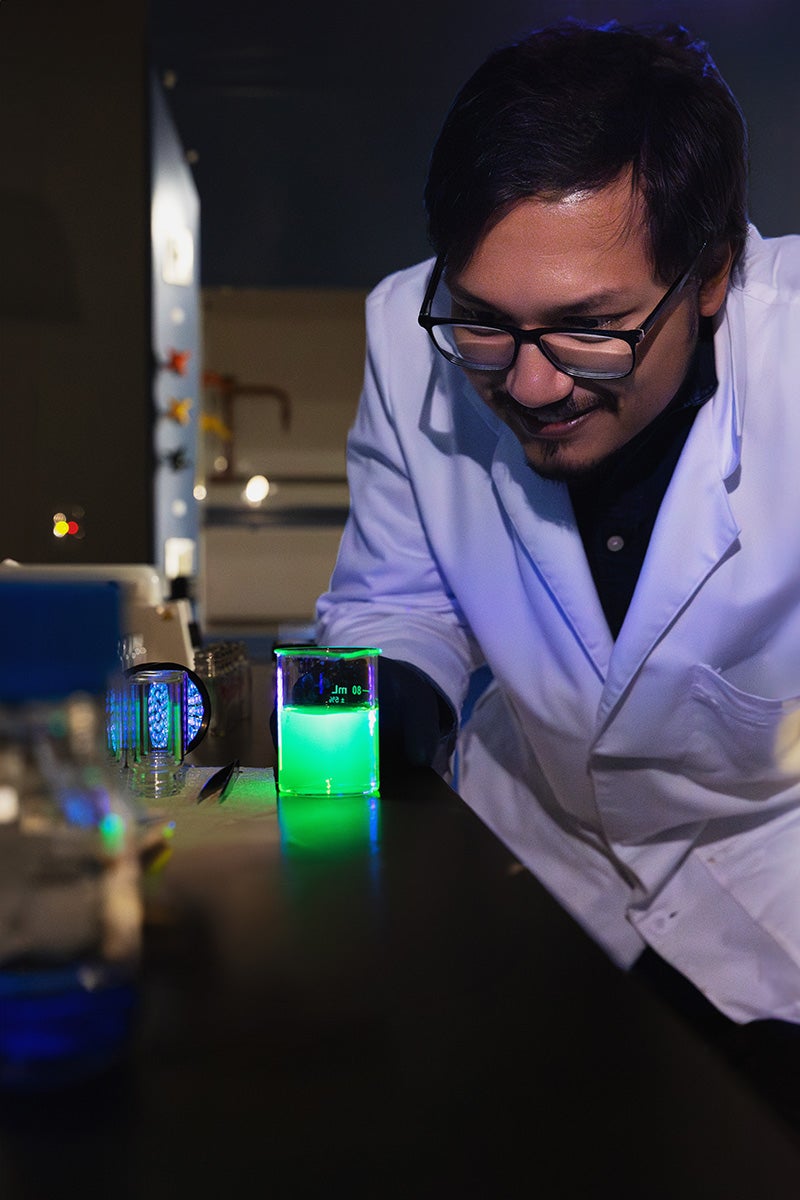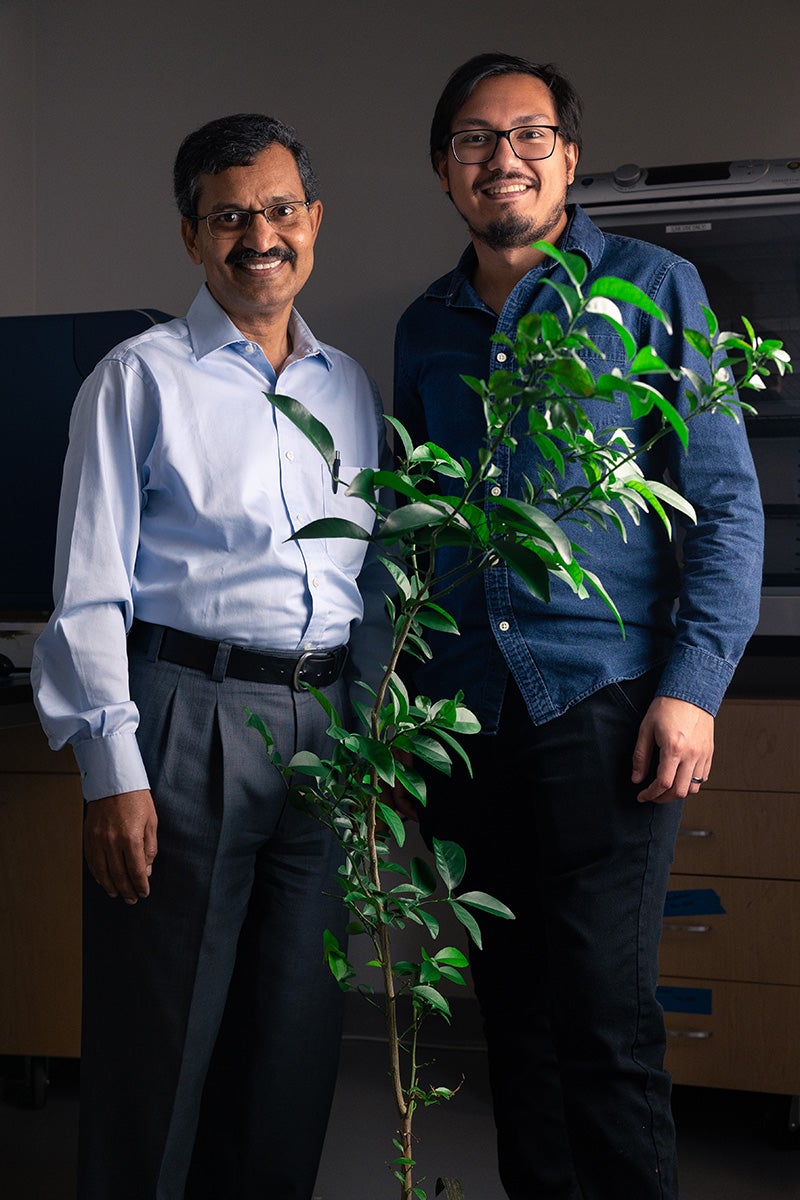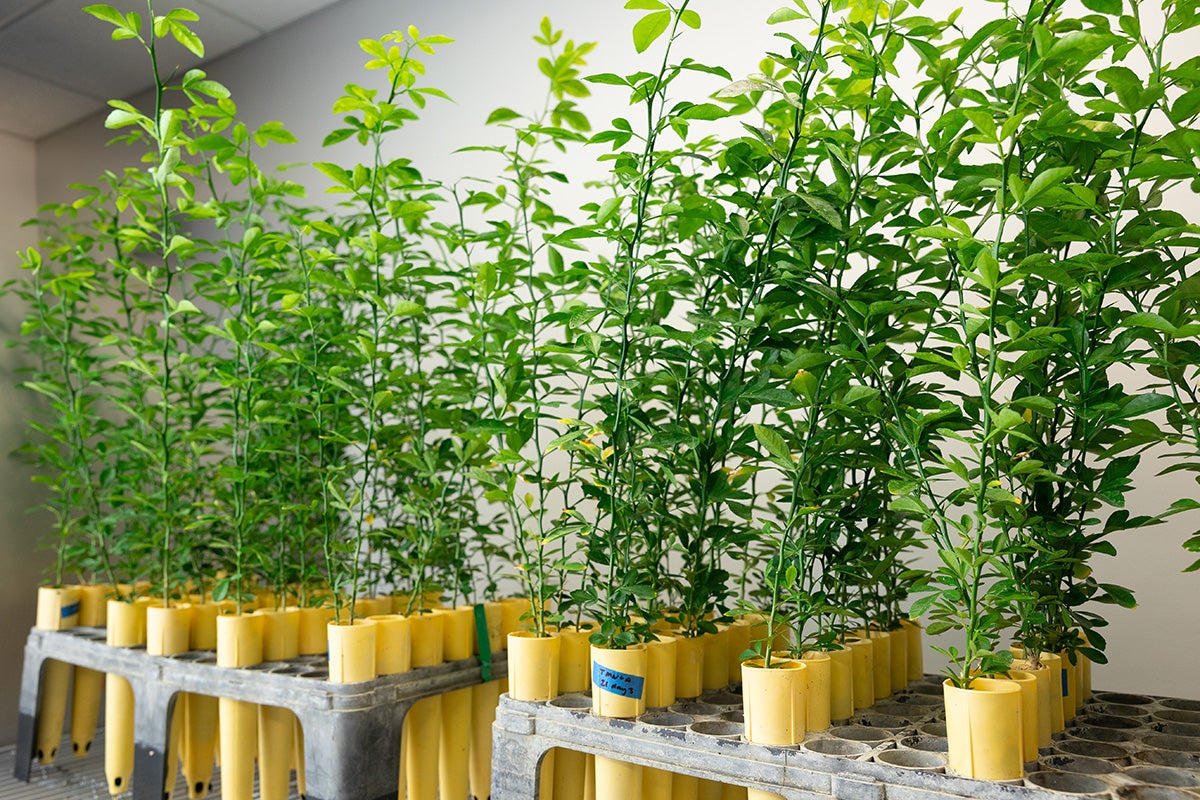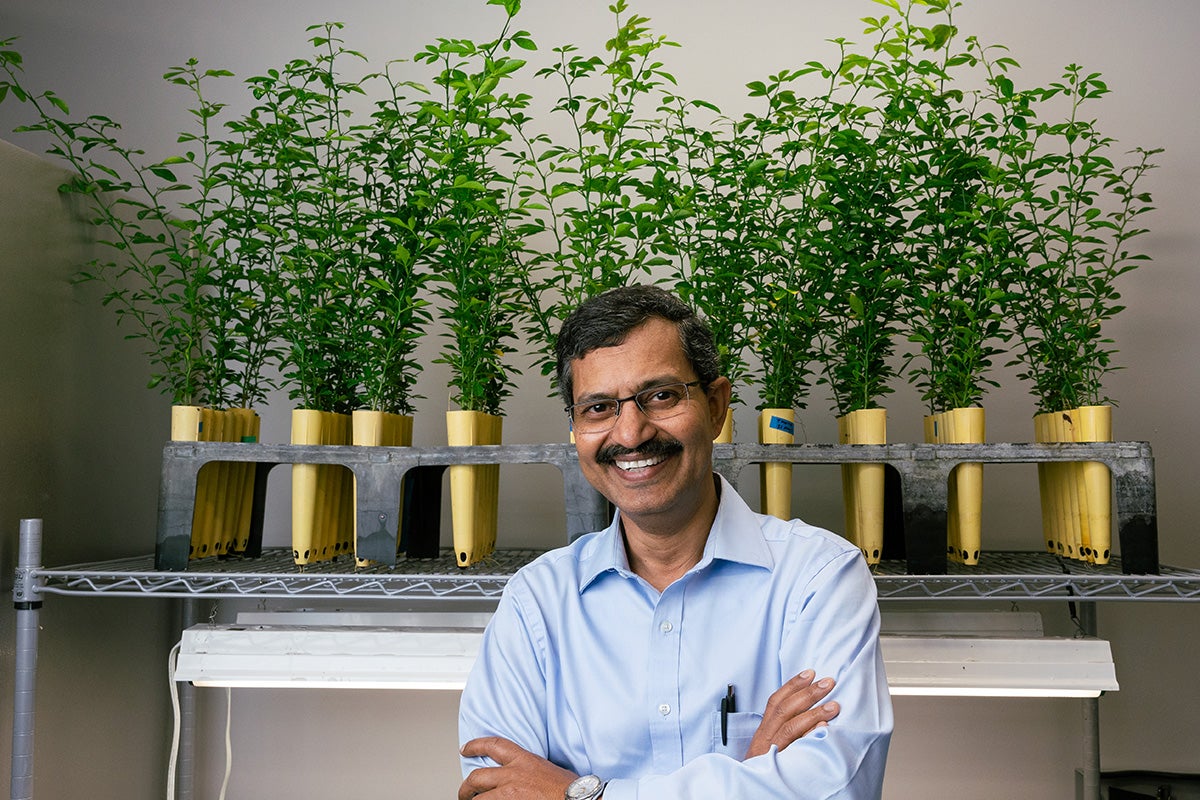Prolific University of Central Florida inventor Swadeshmukul Santra is developing new technologies that hold promise not only for sustainable agriculture, but also for improved medicine.
Santra, a professor associated with UCF’s NanoTechnology Science Center, Department of Chemistry and Burnett School of Biomedical Sciences, has 34 UCF inventions under his belt and leads the university’s Materials Innovation for Sustainable Agriculture (MISA) center, a U.S. Department of Agriculture-National Institute of Food and Agricultural recognized Center of Excellence.
Some of his latest inventions include a nanocomposition that captures and preserves plant materials and agrochemicals and a targeted delivery system for combatting plant disease and providing nutrients at the nano level.
CapTap Keeps Agrochemicals, Pharmaceuticals Active Longer
One recent invention, CapTap, is a gel composition that captures and protects a product’s active ingredients, helping to extend the shelf life and viability. The technology addresses a persistent problem for industry: loss of chemical activity in ingredients before use.
Santra says it offers multiple uses and benefits for agrochemicals and pharmaceuticals, and it protects active ingredients in their original form in storage conditions and biological environments.
The inspiration for the invention came after reading an article about polyphenols, he says.
“Then I started quickly thinking about how the material, a natural product, could be useful,” Santra says. “That’s the beauty of chemistry.”
He contacted one of UCF’s industry partners and acquired 50 kilograms—a drum full of a naturally sourced polyphenol.
“It’s very cost-effective,” Santra says. “And then, after that, the magic happened.”
UCF chemistry doctoral student Jorge Pereira is a co-inventor of the technology.
“Initially, we were interested in it as an alternative to controlling plant pathogens using copper or zinc,” Pereira says.
He says that at the same time, there was also a master’s student looking for a biomedical project on the nano delivery of curcumin. While considering both, Pereira says he realized that he could use the technology to encapsulate and deliver curcumin as a cargo. Later that night, after some restless sleep, Pereira says he realized he could use the technology not only to encapsulate that particular molecule, but you could use it to encapsulate every single molecule that has the same molecular interactions.”
With that, Pereira went to the lab early the next morning.
“I tested the technology with maybe 10 different components, and it seemed that it encapsulated almost all of them with ease,” he says. “We concluded that this capturing technology, based on intermolecular interactions, could be used for agriculture and biomedical.”
With the CapTap technology’s potential, two student researchers were able to develop their master’s theses related to medical issues. Giuliana Giannelli, a co-inventor, published the paper Development of Curcumin-loaded Nanoparticles for Drug Delivery Optimization in the Treatment of Peripheral Nerve Injury. Meanwhile, Research Assistant Sebastian Leon published Development of Creatine-Loaded Nanopolymer Matrices. Surprisingly, he and the team got an email from scientists with the Association for Creatine Deficiencies (ACD).
“We were heavily intrigued because we did not promote this technology in any way,” Pereira says.
He says that the group wanted to know if CapTap could be used to deliver creatine specifically to the brain to help people suffering from Creatine Transporter Deficiency (CTD), which has no proven treatment to date.
According to the ACD website, creatine is essential to sustain the high energy levels needed for muscle and brain development. While patients with CTD may have the necessary enzymes to form creatine, the creatine transporters that carry it to the brain and muscles do not function properly, and the creatine stays in the bloodstream.
“So you start developing something for one aspect, and then you find out that it’s useful for something completely different,” Pereira says.
He says the non-phytotoxic and environmentally friendly technology can encapsulate active ingredients, both organic and inorganic materials, in liquid or gel form. It can also increase the shelf-life of many ingredients in various products, from foods and beverages to agrochemicals and pharmaceuticals. In one example application, the technology enables manufacturers to produce commercially available fertilizers at a lower cost. More information is available on the CapTap technology sheet.

Galvoxite Delivery System Uniquely Targets Pathogens Through Plant Surfaces
Another recent invention enables growers to apply antifungal and antibacterial plant treatments and nutrients more effectively and efficiently. The GalvoxiteTM delivery system targets specific parts of a plant’s leaf tissue, such as areas most susceptible to bacteria and fungi. Growers can also use the technology to deliver micronutrients to targeted plant areas.
“This was my very first project when I joined Dr. Santra’s group,” Pereira says. “So, it’s my baby. It’s been a rebellious baby at that, but over these past four years, we’ve made tremendous discoveries with this formulation, and its behavior is very unique. It fits a niche in nanotechnology for agriculture that was not there.”
Pereira says that the technology’s nano borate formulations have an affinity for certain parts of a plant’s leaf that are prone to bacterial and fungal infections. The idea behind it is that if researchers are able to direct the pesticide to these specific areas, they can spray less pesticide and be more efficient. According to research from the National Library of Medicine, three billion kilograms of pesticides are used worldwide every year, while only 1% of total pesticides are effectively used to control insect pests on target plants.
The UCF inventors discovered that with Galvoxite, they could effectively use oxytetracycline, an antibiotic labeled for peaches.
“We’re able to direct it to these openings in the leaves, called stomata,” Pereira says. “This is where the bacteria go inside the leaf. The invention significantly reduces the plant toxicity of traditional metal-based agrochemicals. More importantly, it increases the efficiency of foliar-sprayed agrochemicals by preferentially targeting and depositing in the stomata and the depressions between leaf cuticles.”
Stomata are pores that allow a plant to breathe, and leaf cuticles protect a plant and help it to retain water.
“Oxytetracycline is just one example of the payloads we can target with the technology,” he says. “We believe we might be able to direct more biostimulants, fungicides, or other antibiotics as well.”
The researchers also successfully used the technology to deliver a nano zinc borate pesticide to combat foliar pathogens on tomato plants.
As added benefit, the technology enhances a plant’s rain fastness and plant absorption and improves pesticide resistance.
The researchers confirmed that a plant’s fruit remains perfect with both technologies.
For more information, view the oxytetracycline targeted delivery technology sheet and the scientific publication on oxytetracycline targeted delivery.

Ongoing and Related Work
For Santra and Pereira, the research continues. With CapTap, the team is working to see if the UCF technology can cross the blood-brain barrier and deliver creatine more efficiently for people with CTD.
“If so, this could be a real game changer for people with this disorder,” Pereira says. “We are very excited.”
Sebastian Leon has applied for a fellowship with the ACD, and if it is granted, the work will be done in the Santra lab.
Santra added that they will be collaborating with fellow UCF researcher Nadine Guo at the NanoScience Technology Center in the Hickman Hybrid Systems Lab, which focuses on constructing next-generation systems for toxicology, drug discovery, and basic biology research.
“They have the right to an in vitro model system that we can use to test whether the findings can show that it can cross the blood-brain barrier,” Santra says. “Nadine is on board and saw the proposal that Sebastian put together for his fellowship.”
He says that the proposal is currently pending with the agency.
In conjunction with the Galvoxite research, Pereira says that the team has developed an adjuvant technology. The Environmental Protection Agency (EPA) recently approved the use of oxytetracycline to help growers combat HLB in citrus plants. However, when injected into citrus trees, Pereira says the antibiotic can cause phytotoxicity and symptoms like bark splitting and staining on the wooden branches.
“This adjuvant technology is liquid, and there are no nanomaterials in this, but it can dissolve oxytetracycline at a neutral pH, which hasn’t been able to be done at an industrial scale, and this is in water,” he says.
The adjuvant technology comprises mostly non-toxic chemicals that growers can easily obtain,” Pereira says. “We’ve started some preliminary tests with a grower, and we’ve seen fantastic results.”
Background and Work to Protect Florida Citrus
Years ago, as a young post-doctoral researcher, chemist, and nanoscientist, Santra welcomed the interdisciplinary research culture he found “unique to the United States.”
Santra attributes that culture to the success of his work.
“We did not have this kind of opportunity while I was in graduate school in India,” Santra says. “The setting there was more like just you and your professor.”
When he joined UCF in 2005, Santra told himself to be passionate about interdisciplinary research. He said his first interdisciplinary research project came in 2008 when a student named Tamre Parsons asked for some lab experience related to citrus research.
“She said I’m interested in doing citrus research because there is a disease here called citrus canker, and I would like to contribute to solving this disease,” Santra says. “I said, OK, that’s good, but I do not know anything about agriculture.”
After discovering citrus canker was a bacterial disease, Santra advised Parsons to contact an agriculture research expert. They found and contacted Jim Graham, Professor Emeritus of soil microbiology at the University of Florida’s Citrus Research and Education Center (CREC) in Lake Alfred, Florida. He has been working on controlling the citrus canker disease for many years.
After the researchers connected, Santra’s team visited the CREC in Lake Alfred and informally discussed their nanotechnology research with Graham.
“I saw that Jim was very excited to learn about it, and that’s how the journey started,” he says.
In addition to developing solutions against citrus canker, Santra and his team have created treatments against the more damaging Huanglongbing (HLB) disease, also known as citrus greening. Three of the patented technologies from Santra’s canker and HLB research are a Silica-Based Antibacterial, Antifungal Nanoformulation, and T-SOL™ Technology: A Chelate-Based Therapeutic Nutrient for Plant Protection, and Zinkicide®: Particulate-Based Therapeutic Agent Fights Citrus Plant Diseases. Santra also interacts with plant pathologists and works alongside growers to combat other crop diseases. For example, those that attack grapes and tomatoes.
Besides agriculture, Santra and his team have worked to help the biomedical and electronics industries.
“We call chemistry a central science. It connects every field,” he says. “That’s a benefit for us to work with many disciplines.
“Whatever success we have gained so far, you see it, there has been a platform,” he says. “When you bring together all different disciplines, people talk to each other. They come up with new ideas.”

Researchers’ Credentials
Santra holds a doctorate in chemistry from the Indian Institute of Technology Kanpur. After graduating, he worked with the University of Florida as a post-doctoral researcher and later as a research assistant professor at the UF Department of Neurological Surgery and Particle Engineering Research Center (PERC). In 2005, Santra joined UCF as a professor at the Nanoscience Technology Center, Department of Chemistry, Department of Materials Science & Engineering, and Burnett School of Biomedical Sciences. He is the director of the UCF Materials Innovation for Sustainable Agriculture (MISA) center, a USDA-NIFA-recognized Center of Excellence.
Pereira graduated from Universidad Nacional Autónoma de Honduras (National University of Honduras) with a degree in industrial chemistry. In 2019 Pereira and his wife emigrated to the U.S. to continue their chemistry studies and become researchers at UCF. He joined Dr. Santra’s lab in 2020 and is currently a graduate research assistant and working toward his Ph.D. Pereira hopes that his accomplishments will inspire young Hondurans to pursue higher education and choose research as a career.
Technology Available for License
To learn more about Santra’s work and additional potential licensing or sponsored research opportunities, contact Andrea Adkins at (407) 823-0138.




